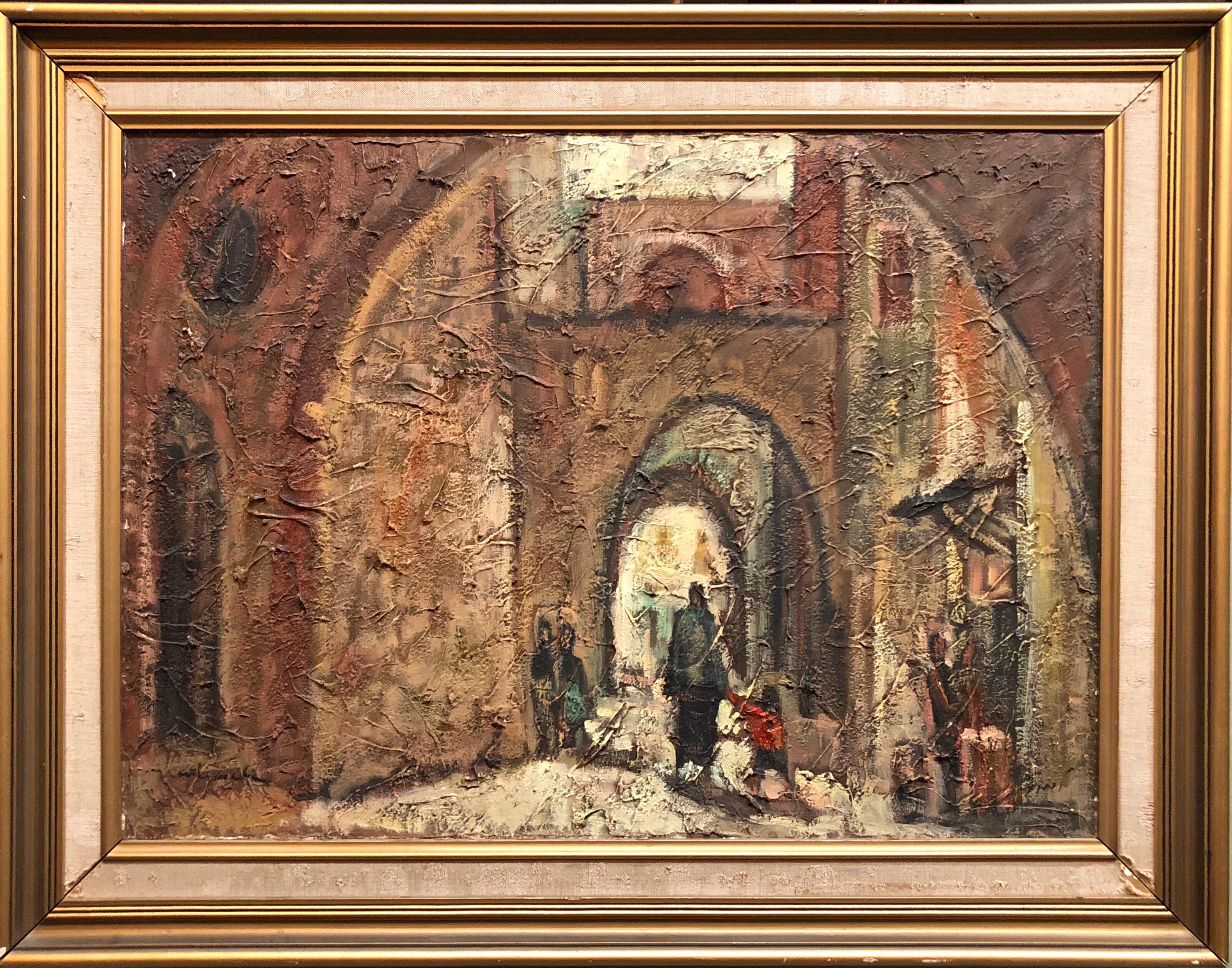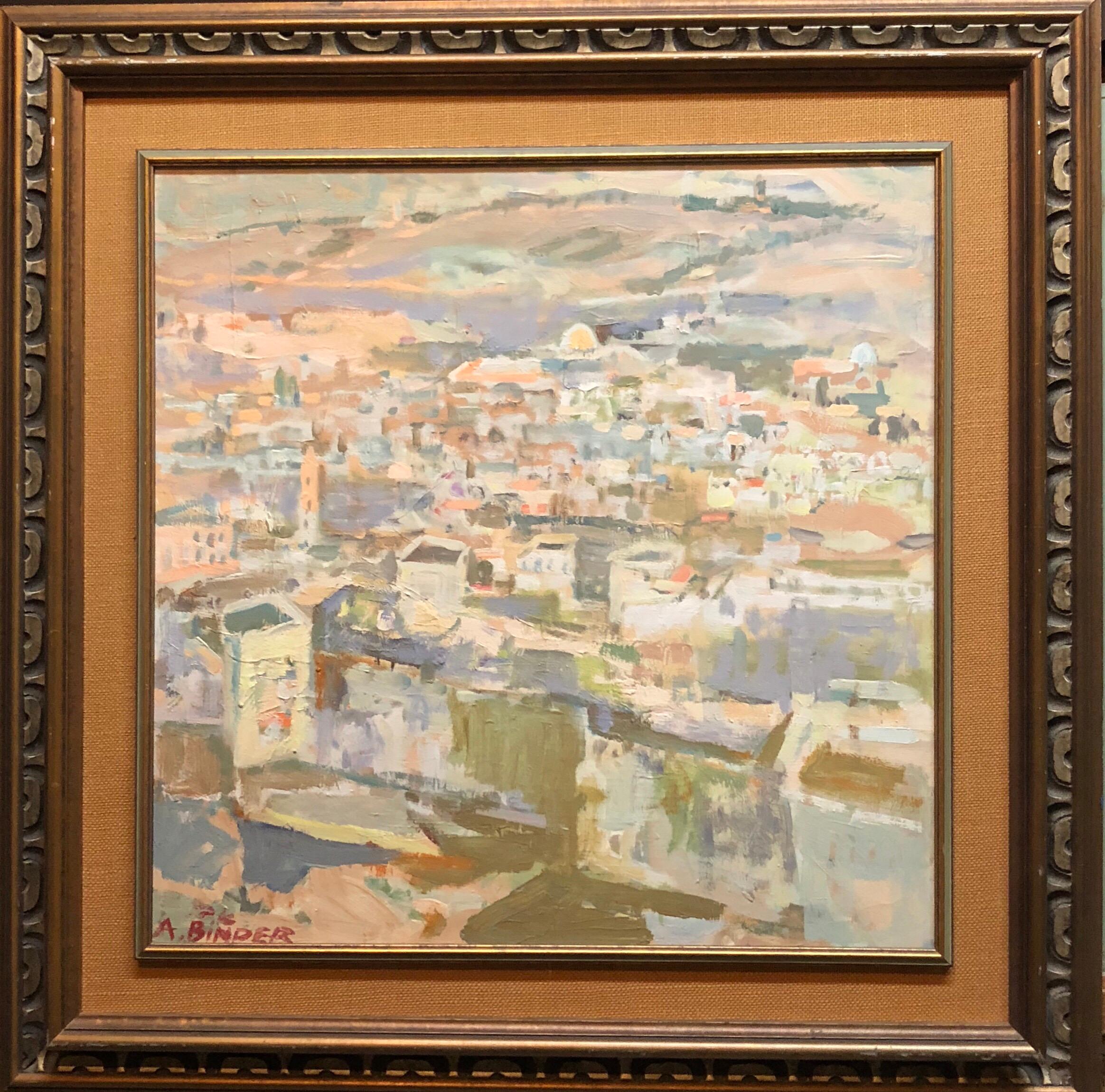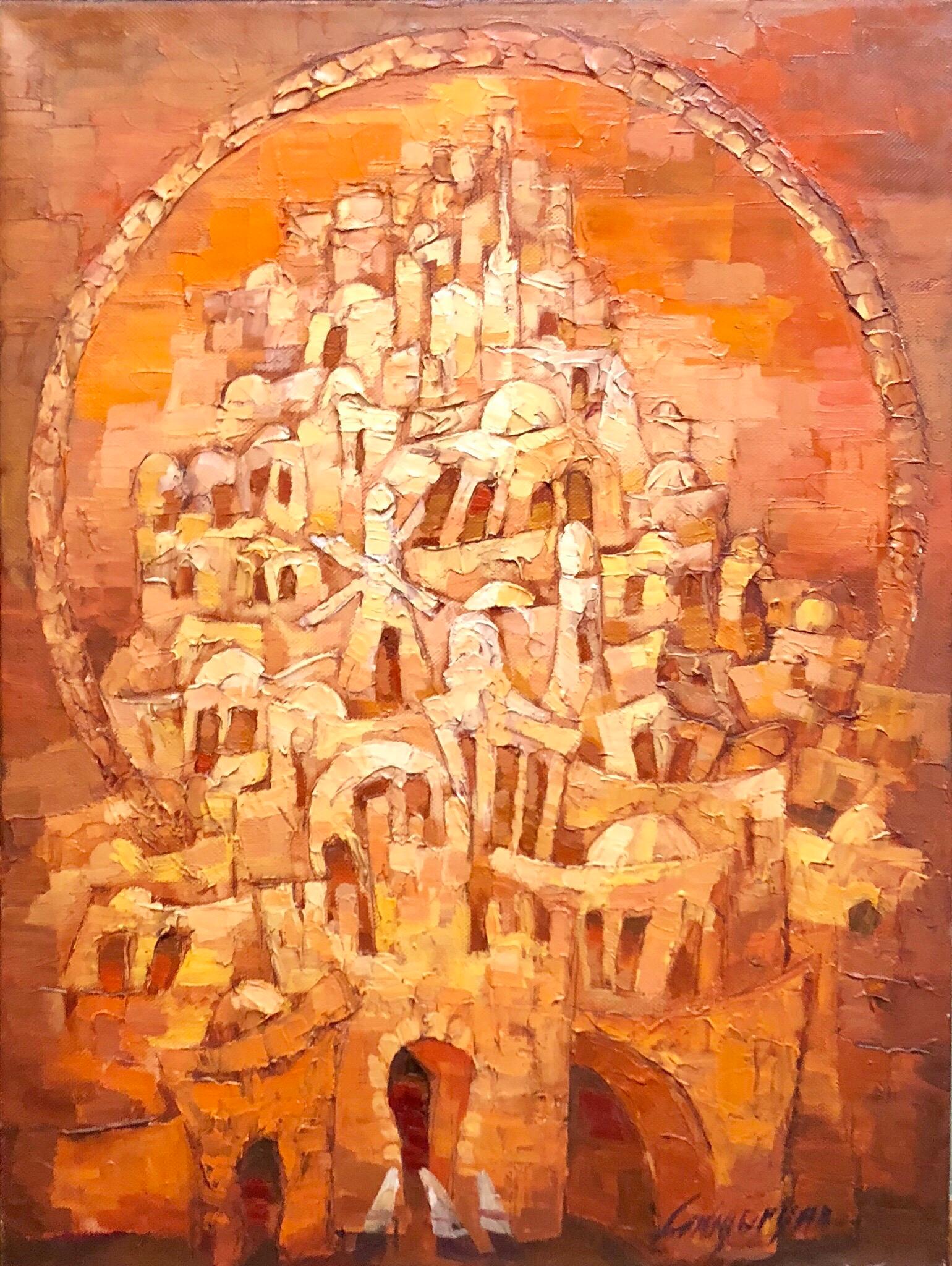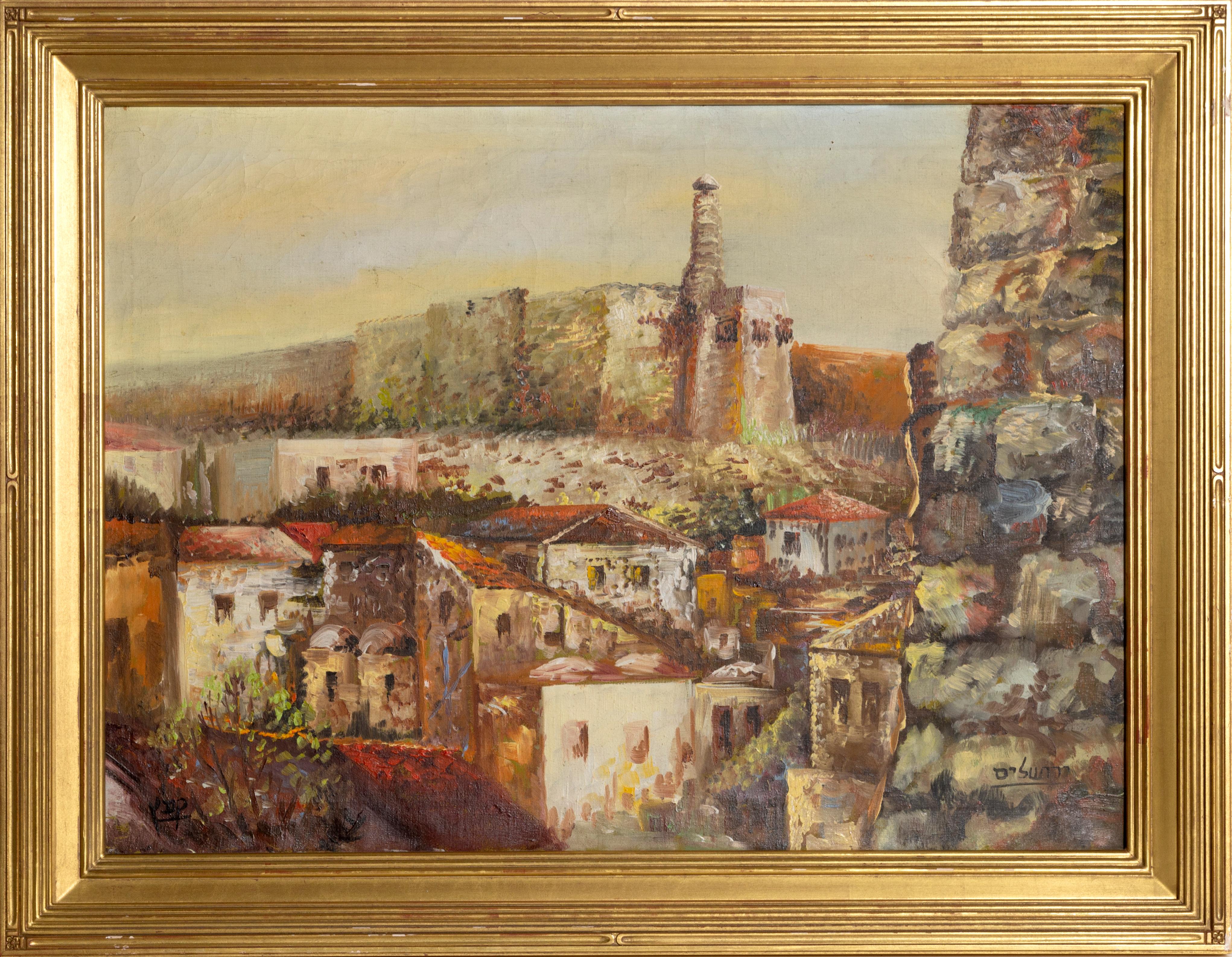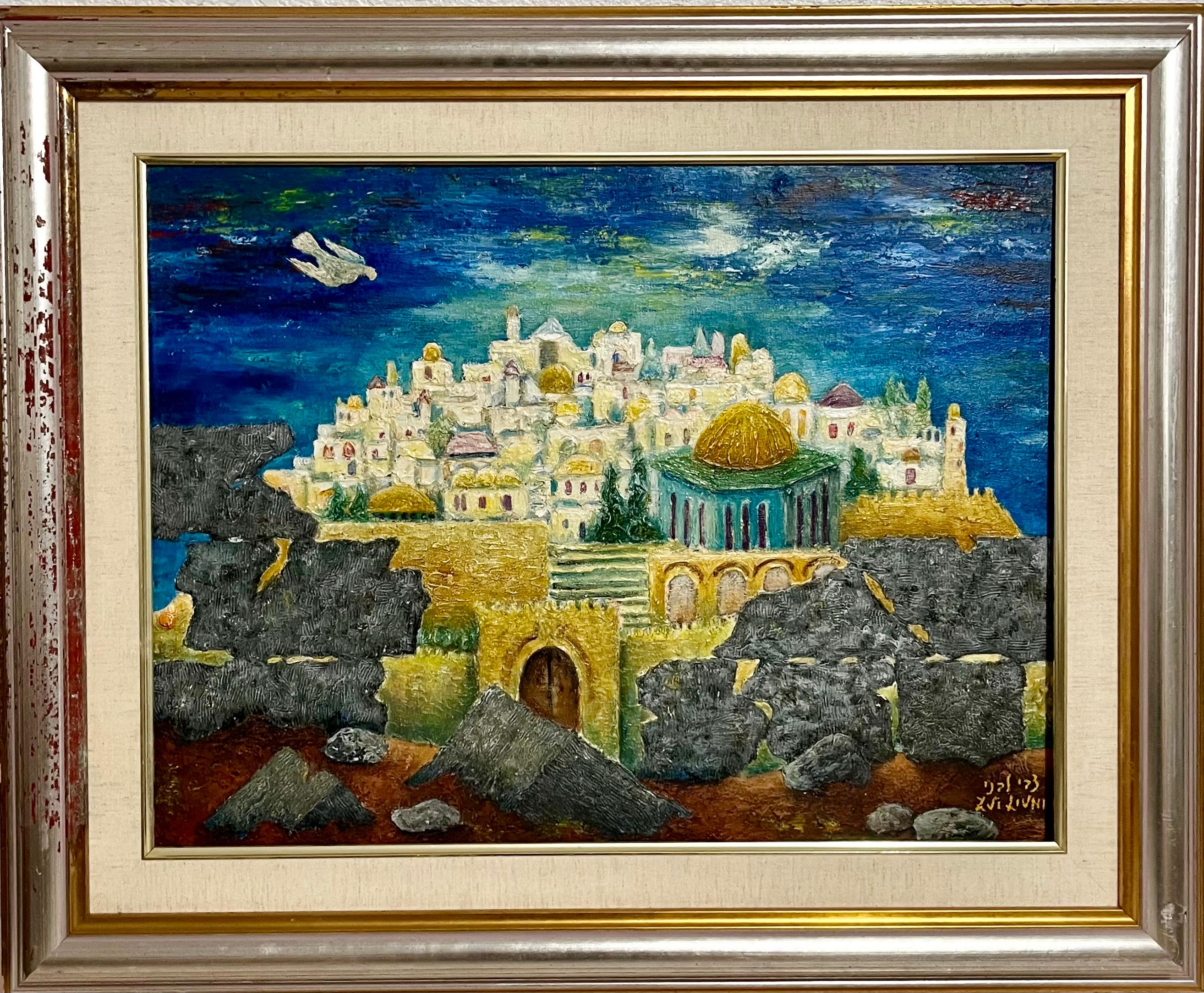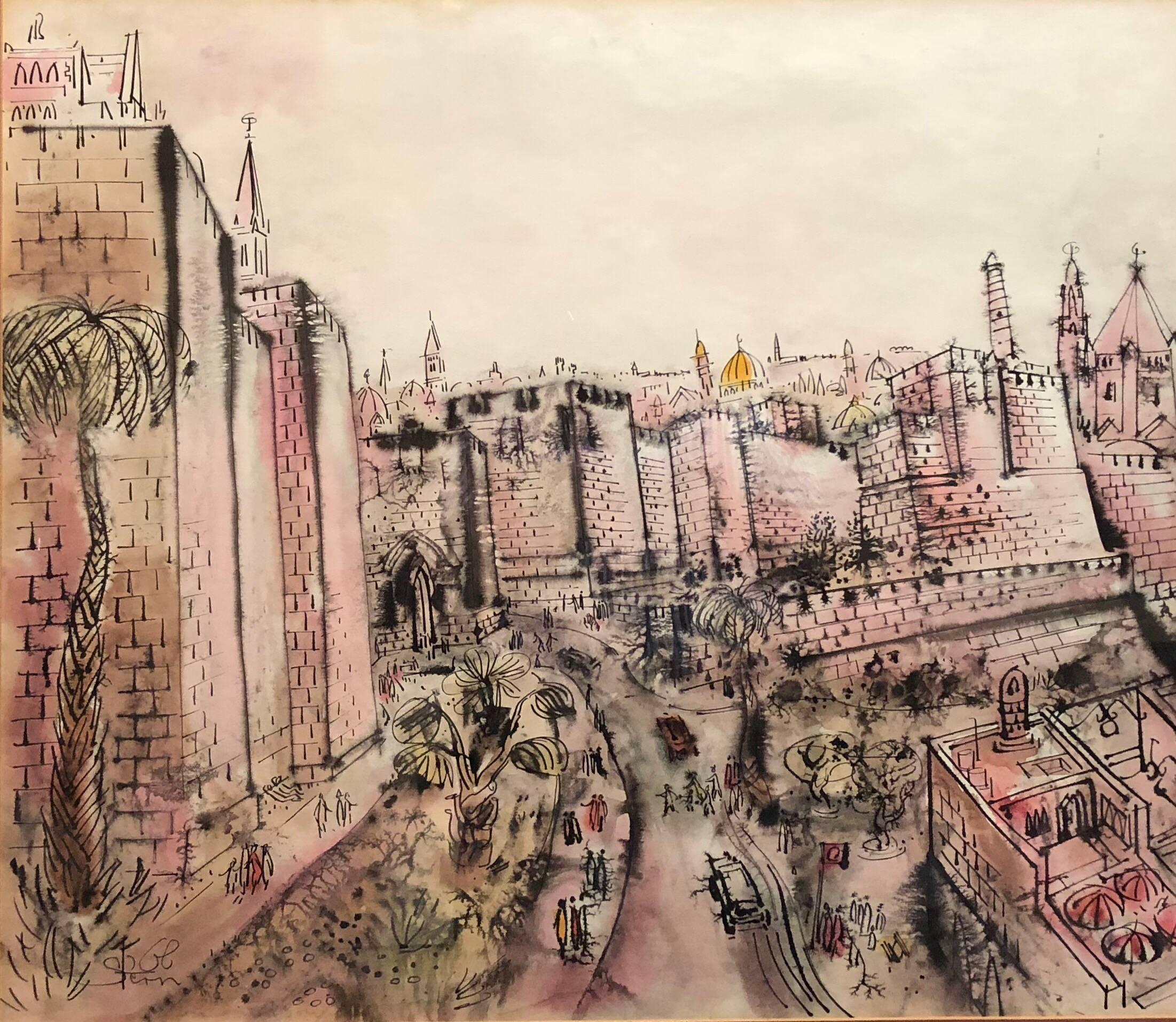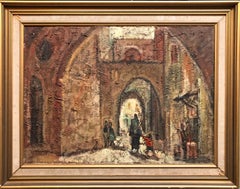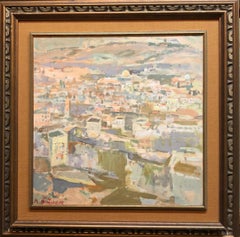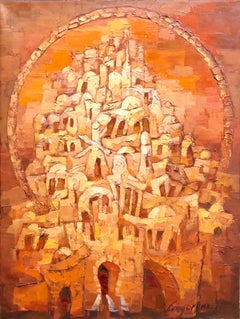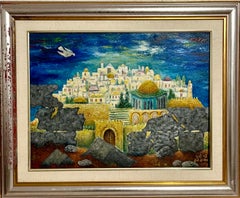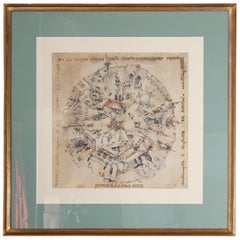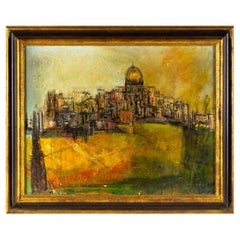Items Similar to Jewish Mystical Kabbalah Oil Painting Jerusalem Cityscape Hebrew Letters Judaica
Want more images or videos?
Request additional images or videos from the seller
1 of 10
David RakiaJewish Mystical Kabbalah Oil Painting Jerusalem Cityscape Hebrew Letters Judaicac.1960's
c.1960's
$2,000
£1,504.81
€1,738.09
CA$2,826.52
A$3,067.21
CHF 1,625.35
MX$37,617.80
NOK 20,113.58
SEK 19,006.27
DKK 12,975.73
About the Item
"Tzadik"
A Surrealist oil painting of old mystical Jerusalem with Hebrew calligraphy
Sight 13.25" x 19.5" ; frame: 21" x 27.25"
David Rakia (1928-2012) was born in Vienna, Austria to a religious family named Shternfeld. His father was a Sofer, a Jewish ritual torah scribe. They emigrated to British mandate Palestine in 1938. He fought and was injured in the War of Independence. After the war he began studying with the artist Mordecai Ardon later joining the Bezalel school in Jerusalem where he studied under Isidor Ascheim and Yakov Eisenscher. He continued his studies at the Ecole des Beaux Arts in Paris, France where he studied painting, lithography and mural art developing a Symbolist style influenced by Surrealism.
His first exhibitions were held at that time at the Musee d'art Moderne in Paris, as well as in Switzerland. Upon his return to Israel in 1960, he began a series of drawings in which Hebrew letters played a central part. His work began to include metaphysical motifs from Judaism, such as the usage of calligraphic Hebrew letters, descriptions of Jerusalem, and the like. A Kabala influenced Expressionism. A year later an extensive individual exhibition of Rakia's work was held at the Tel Aviv Museum. Following the Six Day War, Jerusalem became a central theme in the artist's work. The city, as the essence of the national destiny was concretized both realistically and symbolically, beside the archways, walls and plants, the letters had, from time to time, figurative and abstract shapes.
In the seventies a new spirit filled Rakia's work, beside the previous world of shapes appear horses, in a range of hues and positions, accompanied by musical instruments. Whatever the forms and subjects may be, the reflection of light shining in the background is in all his works. Sometimes the light is green, blue or red, sometimes it is concentrated in a circle, or it appears diffuse. Light is one of the strongest expressions in Rakia's world view as it is reflected in his art. It is an ongoing attempt to touch the mystical experience and the tie between our national existence and the cosmic order around us. The forms and colors are a means of reifying the cosmic cycles of time, light and sound. Man himself appears infrequently in these works, Rakia preferring to place in them his longings to understand and to touch the wonderful system which surrounds his existence.
The life and work of David Rakia have been described in the book written by Dr. Marcel L. Mendelson, which was published by 'Massada' in 1978.
A book about the artist written by Dr. Gideon Ofrat titled Signs was published in 2009.
Rakia's works have been displayed in over 100 individual exhibitions in museums and galleries throughout the world, and they are also to be found in important art collections.
Rakia was a member of the Jewish Painters' Association, Paris, France, 1958
Select Group Exhibitions
2010 Primaries, The Bible (Beit Hatanach) Museum, Tel Aviv
2008 The First Decade Mishkan Le'omanut, Museum of Art, Kibbutz Ein Harod
The Song of the Beggars: The Archetype of the Beggar in Israel Art, Beit Avi Chai, Jerusalem
2004 Salute to Jerusalem Artists, Municipal Art Gallery, Jerusalem
1994 Jerusalem Artists Creat in the Refinery in Ashdod, The Korin Maman Ashdod Museum
1985 Exposition des Artistes de Jérusalem, Grand Palais, Paris, France
1984 Sign and Symbol, Artists' House, Jerusalem
1978 künstler aus Jerusalem, Galerie Gisela Piro, Frankfurt, Germany
1972 Old and New in the Museum Collection, Yad Labanim Museum, Petach-Tikva
Jacob El Hanani, Naftali Bezem, Yosl Bergner, Shraga Weil, Yossef Zaritsky, Anna Ticho, Lea Nikel, Yohanan Simon, Reuven Rubin, Reuven David Rakia, Hermann Struck, Jakob Steinhardt, Boris Schatz, and others.
1969 Art Festival, Painting & Sculpture in Israel , The Exhibition Grounds, Tel Aviv
1967 Artists in Israel for the Defense, Tel Aviv Museum of Art, Helena Rubinstein Pavilion
1965 Group Exhibition, Nora Art Gallery, Jerusalem
1963, 1965 Central Exhibition, Art in Israel, Tel Aviv Art Museum
1962 Spring Exhibition - Jerusalem Artists, Artists' House, Jerusalem
Select Solo Exhibitions
1957 Artists’ House, Jerusalem
1958 The Jewish Center, Zurich, Switzerland
1960 Rakiah, Comedy Gallery, London, England
Recent Paintings, Rina Gallery, Jerusalem
“Rakiah – Peintures”, Galerie Loujetzky, The Hague, Netherlands
1961 Exhibition of Paintings, Tel Aviv Art Museum
1962 Gouache paintings, Nora Art Gallery, Jerusalem
1964 David Rakia, Woodstock Gallery, London
Oil Paintings and Gouaches, Nora Art Gallery, Jerusalem
1966 Exhibition of Paintings, ZOA House, Tel Aviv
1967 The Anne Frank House, Amsterdam
1976 Oil Paintings and Tapestry, Arta Gallery, Jerusalem
1977 Paintings, Graphics, Tapestries, Artists' House, Jerusalem
1979 “Legends of letters“, Museum Ha Aretz, Tel-Aviv
1989 “Exhibition of lithograph and linoleum cuts, Paris 1956-1959 “The Jerusalem Theatre
1999 Jerusalem Theatre, Jerusalem
2003 The Synagogue in Middelburg, Holland
2017 “Rakia's Windows “, Heichal Shlomo - The Wolfson Museum of Jewish Art, Jerusalem
- Creator:David Rakia (1928 - 2012)
- Creation Year:c.1960's
- Dimensions:Height: 21 in (53.34 cm)Width: 27.25 in (69.22 cm)
- Medium:
- Movement & Style:
- Period:
- Condition:good. minor waving to canvas. minor wear commensurate with age. please see photos. strip frame has wear.
- Gallery Location:Surfside, FL
- Reference Number:1stDibs: LU38215785742
About the Seller
4.9
Platinum Seller
Premium sellers with a 4.7+ rating and 24-hour response times
Established in 1995
1stDibs seller since 2014
1,807 sales on 1stDibs
Typical response time: 1 hour
- ShippingRetrieving quote...Shipping from: Surfside, FL
- Return Policy
Authenticity Guarantee
In the unlikely event there’s an issue with an item’s authenticity, contact us within 1 year for a full refund. DetailsMoney-Back Guarantee
If your item is not as described, is damaged in transit, or does not arrive, contact us within 7 days for a full refund. Details24-Hour Cancellation
You have a 24-hour grace period in which to reconsider your purchase, with no questions asked.Vetted Professional Sellers
Our world-class sellers must adhere to strict standards for service and quality, maintaining the integrity of our listings.Price-Match Guarantee
If you find that a seller listed the same item for a lower price elsewhere, we’ll match it.Trusted Global Delivery
Our best-in-class carrier network provides specialized shipping options worldwide, including custom delivery.More From This Seller
View AllJerusalem Old City Cityscape Israeli Modernist Oil Painting Signed in Hebrew
Located in Surfside, FL
Signed Nathanson. Could be the famous artist Avraham Naton (Natanson) I am not certain. it is a very lovely Modernist Israeli landscape.
Avraham Naton (Natanson), Israeli, born in Bessarabia, 1906-1959. Avraham Naton was born in Rani, Bessarabia to a large secular family. In 1935, after Art studies in Romania, he immigrated to the Land of Israel and settled, first, in Givat Haim and later in Ramat Gan. From the 1940s he worked as an Art teacher in Ramat Gan and Givataim. In 1948 he worked as an illustrator at BaMahane Newspaper. He was one of the Founders of New Horizon Group. Between 1952-1959 he was a member of the Milo Club and served as the club secretary.
Education
1930-33 Art Academy, Bucharest, Romania
Teaching
1940's Ramat Gan and Givataim
Awards And Prizes
Jerusalem Prize for Painting and Sculpture
1942 Dizengoff Prize
1953 Milo Club Prize
New Horizons, The Ofakim Hadashim art movement began with a group of artists who mounted an exhibition in Tel Aviv's Habima national theater in December 1942, under the name "The Group of Eight". The group evolved into a coherent artistic movement only after the founding of the state of Israel in 1948. Members of the school included Arie Aroch, Zvi Meirovitch, Avraham Naton (Natanson), Avigdor Stematsky and Yehezkel Streichman. The work of sculptor Dov Feigin also appeared in the catalog of the 1942 exhibition, though it was not displayed. In February 1947 five of the original members of the group joined Joseph Zaritsky...
Category
1950s Modern Landscape Paintings
Materials
Canvas, Oil
Large Abstract landscape of Jerusalem Israeli Oil Painting Judaica
By Avraham Binder
Located in Surfside, FL
Avraham Binder was born in 1906 in Vilnius (or Vilna), now part of Lithuania. He began painting at an early age and completed the prescribed studies in painting at the academy of art...
Category
20th Century Modern Landscape Paintings
Materials
Canvas, Oil
Old City Jerusalem Landscape Russian Israeli Judaica Oil Painting
By Marina Grigoryan
Located in Surfside, FL
Genre: Realism
Subject: Portrait
Medium: Oil
Surface: Canvas
Country: Israel
Dimensions: 31.5x23.5
Marina Grigoryan (Armenian/Russian/Israeli) was born in 1963 in Dushanbe, Russia.
...
Category
20th Century Impressionist Figurative Paintings
Materials
Canvas, Oil
Modernist Old City Jerusalem Israel Landscape Oil Painting Zvi Livni Judaica Art
By Zvi Livni
Located in Surfside, FL
Jerusalem Landscape by Zvi Livni
Frame: 25.5" X 31.5"
Image: 17.5 X 23.5"
Zvi Livni was born in the town of Lodz in Poland, and commenced his artistic education at the Art Academy in Warsaw. He came to Israel as a young man. Here he lived for many years in a kibbutz and was one of the founders of the artist group of the Kibbutz Artzi. He left Israel on several occasions in order to continue his studies and spent much time in the 1930's in Germany, France and Italy. Worked in lithograph printing and oil painting. Paintings at: President's Residence, Jerusalem,Museum of Art, Toronto, Boston University Museum. A founder of the Artists' Quarter, Safed. From 1953 lived in Safed.
He was among the founders of the famous Israeli Artists' Colony in Safed, where he lives and works most of the year and where he exhibits at a permanent one-man show.
He has also achieved a reputation as illustrator of various books and illuminator of Passover Haggadot.
His paintings are to be found in many museums and well-known private collections in Israel, U.S.A., Canada and Europe, including the Residence of the President of the State of Israel, Jerusalem; the Museum of Art in Toronto, Canada; the Museum of Modern Art, Brandeis University, Boston; the Museum of Art, Yale University, New Haven; the Brooklyn Museum, New York.
He was included in the show Art in Israel Tel Aviv Museum of Art, 1951
Artists: Mordechai Avnieli, Aviva Uri...
Category
Mid-20th Century Folk Art Landscape Paintings
Materials
Canvas, Oil
Old City Jerusalem City Walls landscape Scene Painting, Judaica
By Jossi Stern
Located in Surfside, FL
Vibrant Gouache and watercolor painting by Israeli master JOSSI STERN. on paper mounted to board. 31x34.75, 23.5x27.5 without frame.
Hungary, b. 1923, d. 1992
Jossi (Yossi) Stern, son of David and Katerina, was born in the Bakon Hills of Hungary, in 1923. He was already drawing when at the age of ten he moved with his family from the Bakon Hill region to the considerably more cosmopolitan Budapest.
Recognizing the looming threat of Hitler and the pending Nazi invasion of Hungary, in 1940, at the age of seventeen, the young artist made his way to Palestine aboard the Sakaria, an old ship heavily crowded with 2,300 other refugees. Before reaching the shores of Palestine, then under the British Mandate, the British Navy intercepted the ship and declared Stern and all those aboard illegal immigrants. Stern was sent to a prison camp where he remained incarcerated by the British for six months.
In 1943, having spent a few years doing agricultural work, Stern was encouraged by close friends who recognized his artistic talent to enroll in the prestigious Bezalel School of the Arts in Jerusalem. An outstanding student, he eventually became a highly respected teacher of Graphic Arts at Bezalel.
Stern is recognized in Israel as having been one of the country's premier artists...
Category
20th Century Modern Figurative Paintings
Materials
Watercolor, Gouache, Illustration Board
Mod 1970's Israeli Judaica Folk Art Jerusalem View Enamel on Copper Painting
Located in Surfside, FL
This is a masterfully executed wall hanging enamel on copper painting of Jerusalem. it is signed in Hebrew. Israel has had a Vibrant Folk Art, Naive art scene for a long time now artists like Yisrael Paldi, Nahum Guttman, Reuven Rubin had naive periods. The most well know of the strict naive artists are Shalom of Safed, Irene Awret...
Category
20th Century Folk Art Landscape Paintings
Materials
Copper, Enamel
You May Also Like
View of Jerusalem, Framed Impressionist Landscape Oil Painting
Located in Long Island City, NY
Artist: Unknown XXth Century
Title: View of Jerusalem
Medium: Oil on canvas, signed and titled in Hebrew
Image Size: 19.5 x 26.5 in. (49.53 x 67.31 cm)
Frame Size: 25 x 32 inches
Category
Mid-20th Century Modern Landscape Paintings
Materials
Oil, Canvas
Jerusalem Art Framed by Obolski Israel
Located in Moreno Valley, CA
Jerusalem art framed by Obolski Israel.
Category
Late 20th Century Israeli Modern Decorative Art
Materials
Paper
Judaica Oil Painting By Shmuel Brand
By Shmuel Brand
Located in Long Island City, NY
Artist: Shmuel Brand, German/Israeli (1921 - )
Title: Untitled
Year: 1980
Medium: Oil with Mixed Media on Masonite, signed l.l
Size: 39.5 x 27.5 in. (100.33 x 69.85 cm)
Category
1980s Abstract Abstract Paintings
Materials
Masonite, Oil
Mid Century Modern Cityscape Oil Painting On Canvas
Located in Franklin Park, IL
Mid-Century Modern cityscape oil painting on canvas
This piece measures: 33.75 wide x 1.75 deep x 27.75 inches high
This Painting is in e...
Category
Vintage 1970s American Mid-Century Modern Paintings
Materials
Canvas, Paint
Jerusalem, Contemporary Impressionist Landscape, 2023, Limited Edition
By Topher Straus
Located in Golden, CO
Immerse yourself in the timeless tapestry of Jerusalem with Topher Straus's captivating Limited Edition artwork. The golden Dome of the Rock dominates the ...
Category
2010s Abstract Impressionist Landscape Paintings
Materials
Metal
Impressionist Landscape Painting of the Holy City of Jerusalem
By Frank Freed
Located in Houston, TX
Lovely impressionistic painting of the Holy City of Jerusalem by Texas artist Frank Freed.
Dimensions of painting itself: H 18 in. x W 24 in.
Artist Biog...
Category
1960s Impressionist Landscape Paintings
Materials
Acrylic
